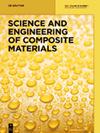复合铸造与APB复合制备Al/TiO2复合材料的磨损性能
IF 1.6
4区 材料科学
Q3 Materials Science
引用次数: 2
摘要
复合铸造法是制备金属基复合材料的常用技术之一。但在此过程中面临的主要挑战之一是金属基体内部的增强细分(颗粒)分布不均匀,并且由于金属基体与增强颗粒之间的结合强度较低,最终生产的复合材料缺乏理想的力学性能。为了消除这些困难,提高这类复合材料的力学性能,本研究利用累积压合(WAPB)技术作为一种辅助技术来提高铸造Al/TiO2复合材料棒材的力学和微观组织演变。采用拉伸试验、平均维氏显微硬度试验、磨损试验和扫描电镜(SEM)对复合材料的微观组织演变和力学性能进行了比较。SEM结果表明,在较高的APB步骤中,大的二氧化钛(TiO2)团簇被破坏,TiO2颗粒均匀分布。结果表明,累积成形步骤可提高复合材料的力学性能。采用复合铸造和APB相结合的工艺可以制备出稠度高、显微组织和力学性能好的Al/TiO2复合材料。本文章由计算机程序翻译,如有差异,请以英文原文为准。
Wear properties of Al/TiO2 composites fabricated via combined compo-casting and APB process
Abstract Compo-casting method is one of the popular techniques to produce metal-based matrix composites. But one of the main challenges in this process is un-uniform spreading of reinforced subdivisions (particles) inside the metallic matrix and the lack of desirable mechanical properties of the final produced composites due to the low bonding strength among the metal matrix and reinforcement particles. To remove these difficulties and to promote the mechanical properties of these kind of composites, the accumulative press bonding (WAPB) technique as a supplementary technique to heighten the mechanical and microstructural evolution of the casted Al/TiO2 composite bars was utilized as a novelty in this study. The microstructure evolution and mechanical properties of these composites have been compared with various WAPB steps using tensile test, average Vickers micro hardness test, wear test and scanning electron microscopy (SEM). The SEM results revealed that during the higher APB steps, big titanium dioxide (TiO2) clusters are broken and the TiO2 particles are distributed uniformly. It was shown that cumulating the forming steps improved the mechanical properties of the composites. In general, combined compo-casting and APB process would consent making Al/TiO2 composites with high consistency and good microstructural and mechanical properties.
求助全文
通过发布文献求助,成功后即可免费获取论文全文。
去求助
来源期刊

Science and Engineering of Composite Materials
工程技术-材料科学:复合
CiteScore
3.10
自引率
5.30%
发文量
0
审稿时长
4 months
期刊介绍:
Science and Engineering of Composite Materials is a quarterly publication which provides a forum for discussion of all aspects related to the structure and performance under simulated and actual service conditions of composites. The publication covers a variety of subjects, such as macro and micro and nano structure of materials, their mechanics and nanomechanics, the interphase, physical and chemical aging, fatigue, environmental interactions, and process modeling. The interdisciplinary character of the subject as well as the possible development and use of composites for novel and specific applications receives special attention.
 求助内容:
求助内容: 应助结果提醒方式:
应助结果提醒方式:


